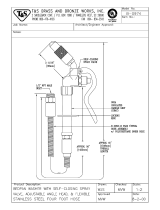
This appliance conforms to current
safety requirements. Inappropriate
use can, however, lead to personal
injury and damage to property.
To avoid the risk of accidents and
damage to the appliance, please
read these instructions carefully
before using it for the first time. They
contain important information on its
safety, use and maintenance.
Keep these instructions in a safe
place and pass them on to any
future owner.
Correct application
~
This dishwasher is designed for
domestic use and for use in similar
environments by guests in hotel or
motel rooms, bed & breakfasts and
other typical living quarters to clean
domestic crockery, cutlery and
glassware. This does not include
common/shared facilities or commercial
facilities within hotels, motels or bed &
breakfasts.
Any other usage is at the owner's risk.
Miele cannot be held liable for damage
resulting from incorrect or improper use
or operation.
~
This dishwasher is not suitable for
outdoor use.
~
This appliance is not intended for
use by persons (including children)
with reduced physical, sensory or
mental capabilities, or lack of
experience and knowledge, unless they
have been given supervision or
instruction concerning its use by a
person responsible for their safety.
Safety with children
~
This appliance is not a toy! To avoid
the risk of injury, keep children well
away and do not allow them to play in
or around the dishwasher, or to use the
controls. They will not understand the
potential dangers posed by it. They
should be supervised whenever you
are working in the kitchen. There is a
danger that children playing might shut
themselves in the dishwasher.
~
Older children may only use the
dishwasher when its operation has
been clearly explained to them and
they are able to use it safely,
recognising the dangers of misuse.
~
Keep children away from
detergents. Dishwasher detergents
contain irritants and corrosive
ingredients which can cause burning in
the mouth, nose and throat if
swallowed, or inhibit breathing. Keep
children away from the dishwasher
when the door is open. There could still
be detergent residues in the cabinet.
Consult a doctor immediately if your
child has swallowed or inhaled
detergent.
Warning and safety instructions
6





















